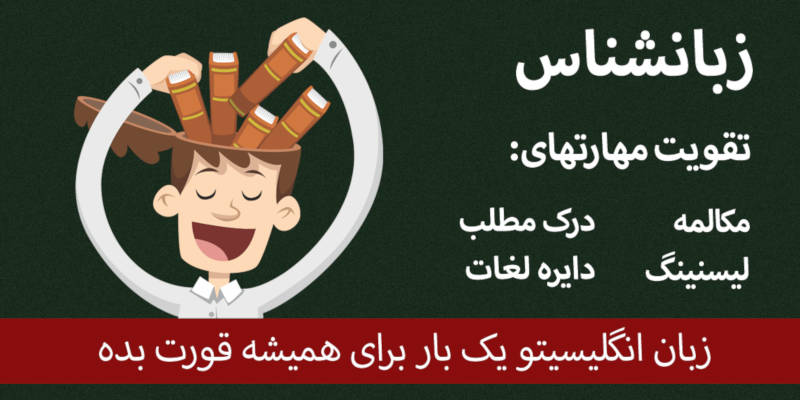سرفصل های مهم
Chapter 2 - 5
توضیح مختصر
- زمان مطالعه 0 دقیقه
- سطح خیلی سخت
دانلود اپلیکیشن «زبانشناس»
فایل صوتی
برای دسترسی به این محتوا بایستی اپلیکیشن زبانشناس را نصب کنید.
ترجمهی درس
متن انگلیسی درس
05 linguistics
Dunstan Baby Language
It is common knowledge that a crying baby is a discontent baby.
The trick for caregivers is to figure out why infants are unhappy.
A new method of parent/infant communication has been introduced that might make determining what a baby wants much easier.
Dunstan Baby Language is a concept stating that all babies aged zero to three months, regardless of nationality and ethnicity, use five distinctive sounds to communicate their needs.
Dunstan Baby Language was conceived in Australia in 2006 by Priscilla Dunstan when she recognized that her infant son repeatedly made certain noises, or “sound reflexes.”
The sound reflexes are cues that the baby has needs to be met, such as hunger or tiredness.
If the need goes unattended by the caregiver, the infant begins to cry.
Dunstan took notes detailing the specific sound reflexes and whether the action she took in response had soothing effects.
Through her empirical studies, she determined there are five sounds.
“Neh” indicates hunger, “owh” communicates tiredness, “heh” expresses discomfort like needing a new diaper, “eairh” indicates flatulence, and “eh” signals the need for burping.
Dunstan claims these noises are produced by the infant’s body in response to a need.
The theory states that once caregivers can recognize the different sound reflexes, they can respond accordingly to the needs indicated by the cues.
The Dunstan Baby Language website claims that eight years of research has gone into testing this theory of infant communication.
According to Dunstan, research involving over a thousand babies and parents has been performed in seven countries with over thirty different nationalities.
Independent research conducted in Australia, the United States, and the United Kingdom confirmed the system is effective.
The Dunstan website also gives percentage statistics.
For example, it claims that ninety percent of all mothers found Dunstan Baby Language to be very beneficial, while one hundred percent of all new mothers rated it as highly valuable.
Caregivers subscribing to the Dunstan Baby Language theory seem to benefit from its use.
Seventy percent reported that their babies were easier to calm and they felt more confident in their childcare skills.
Thus, they gained more self-esteem and experienced a reduction in stress.
Also, two out of three fathers reported less stress and a happier marriage as an immediate result of more paternal involvement while using the Dunstan system.
Some of the statistical data regarding the benefits is specific to the United States and Australia.
For example, fifty percent of caregivers were able to engage in more uninterrupted sleep, and reported feeling a closer bond with their babies.
The technique for learning Dunstan Baby Language is sold on DVDs available for order online.
This makes it a source of information that can be watched at leisure, repeatedly if needed, until parents are confident in their ability to recognize the sound reflexes. In spite of the supposed benefits, there are several criticisms that have surfaced regarding the claims made by Dunstan.
One problem is that there is no methodology given for Dunstan’s research, only vague claims of success from caregivers who participated in the research process.
This does not give the concrete data “needed to 5_ prove the validity of the theory. Dunstan claims that this “language is shared by all babies throughout the world.”
Yet there is no specific information on how many babies were studied, where they were studied (except for a brief mention of three English-speaking countries), what language the babies were commonly exposed to, or how the studies were conducted.
Also, researchers in the fields of linguistics and early language development question that the sounds Dunstan refers to as a language can be construed as each.
They do not consider the sound reflexes to be formal.
They have not been recorded in the International Phonetic Alphabet, and it is not clear what the phonemes comprising the five sound reflexes mean.
It is also unclear if babies make these sounds inherently or if they are conditioned to make these sounds.
For example, if a mother feeds her baby every time the baby utters the sound reflex “neh,” the baby may make the connection after a time.
The baby may then make the sound to get food when desired.
If Dunstan Baby Language does what it claims, then it will certainly be a sought-after technique to aid parents and infants alike.
if it does not live up to what it promises, then caregivers will just have to go back to the old-fashioned way of baby care, which has worked for centuries.
مشارکت کنندگان در این صفحه
تا کنون فردی در بازسازی این صفحه مشارکت نداشته است.
🖊 شما نیز میتوانید برای مشارکت در ترجمهی این صفحه یا اصلاح متن انگلیسی، به این لینک مراجعه بفرمایید.
